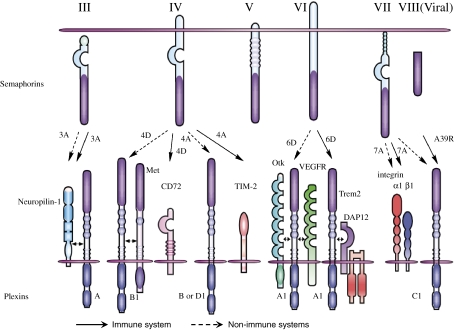Figure 1.
Representative semaphorins and their receptors. Among the eight subclasses of semaphorins, class I and II semaphorins are found in invertebrates (not shown in figure) and class III–VII are vertebrate semaphorins. Classes II and III and viral semaphorins are secreted, whereas class IV–VI are transmembrane. Class VII represents GPI-anchored proteins. Sema3A directly binds NP-1 and associates with plexin-A1, resulting in inducing plexin-A-mediated signals. Although Sema4D binds to plexin-B1 in neurons, plexin-B1 couples with Met in epithelial cells and induces Sema4D-mediated cell outgrowth. In the immune system, Sema4D binds to CD72, which promotes B cell and DC activation. Sema4A recognizes plexin-B and D1 in the non-immune systems but uses TIM-2 as a receptor for T cell activation in the immune system. During cardiogenesis, plexin-A1 associates with OTK or VEGFR2 at distinct sites. However, plexin-A1 forms a receptor complex with TREM-2-DAP12, which is critical for DC activation and osteoclastogenesis. Sema7A has two types of receptors: α1β1 integrin for macrophage activation and plexin-C1 for inhibition of cell adhesion. Viral semaphorin A39R also recognizes plexin-C1 and modulates dendritic cell function.

